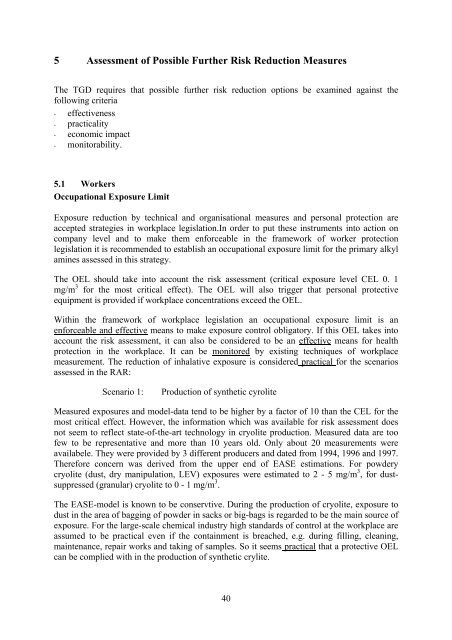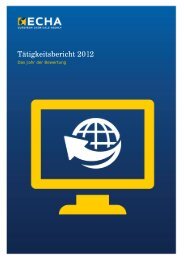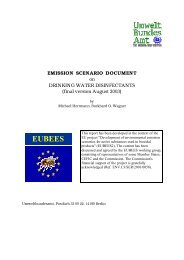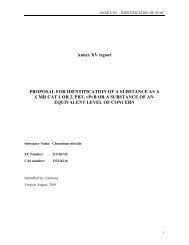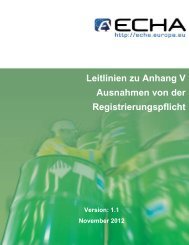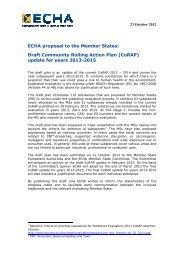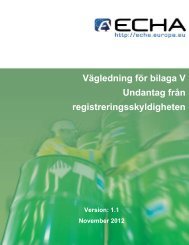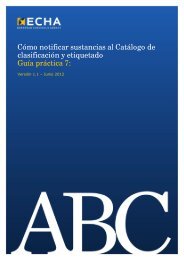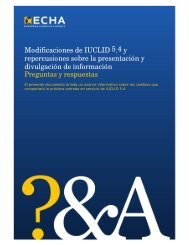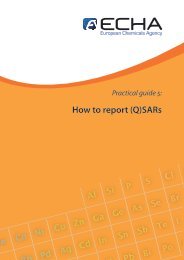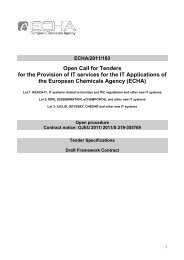Strategy For Limiting Risks Human Health Draft of ... - ECHA - Europa
Strategy For Limiting Risks Human Health Draft of ... - ECHA - Europa
Strategy For Limiting Risks Human Health Draft of ... - ECHA - Europa
You also want an ePaper? Increase the reach of your titles
YUMPU automatically turns print PDFs into web optimized ePapers that Google loves.
5 Assessment <strong>of</strong> Possible Further Risk Reduction Measures<br />
The TGD requires that possible further risk reduction options be examined against the<br />
following criteria<br />
- effectiveness<br />
- practicality<br />
- economic impact<br />
- monitorability.<br />
5.1 Workers<br />
Occupational Exposure Limit<br />
Exposure reduction by technical and organisational measures and personal protection are<br />
accepted strategies in workplace legislation.In order to put these instruments into action on<br />
company level and to make them enforceable in the framework <strong>of</strong> worker protection<br />
legislation it is recommended to establish an occupational exposure limit for the primary alkyl<br />
amines assessed in this strategy.<br />
The OEL should take into account the risk assessment (critical exposure level CEL 0. 1<br />
mg/m 3 for the most critical effect). The OEL will also trigger that personal protective<br />
equipment is provided if workplace concentrations exceed the OEL.<br />
Within the framework <strong>of</strong> workplace legislation an occupational exposure limit is an<br />
enforceable and effective means to make exposure control obligatory. If this OEL takes into<br />
account the risk assessment, it can also be considered to be an effective means for health<br />
protection in the workplace. It can be monitored by existing techniques <strong>of</strong> workplace<br />
measurement. The reduction <strong>of</strong> inhalative exposure is considered practical for the scenarios<br />
assessed in the RAR:<br />
Scenario 1: Production <strong>of</strong> synthetic cyrolite<br />
Measured exposures and model-data tend to be higher by a factor <strong>of</strong> 10 than the CEL for the<br />
most critical effect. However, the information which was available for risk assessment does<br />
not seem to reflect state-<strong>of</strong>-the-art technology in cryolite production. Measured data are too<br />
few to be representative and more than 10 years old. Only about 20 measurements were<br />
availabele. They were provided by 3 different producers and dated from 1994, 1996 and 1997.<br />
Therefore concern was derived from the upper end <strong>of</strong> EASE estimations. <strong>For</strong> powdery<br />
cryolite (dust, dry manipulation, LEV) exposures were estimated to 2 - 5 mg/m 3 , for dustsuppressed<br />
(granular) cryolite to 0 - 1 mg/m 3 .<br />
The EASE-model is known to be conservtive. During the production <strong>of</strong> cryolite, exposure to<br />
dust in the area <strong>of</strong> bagging <strong>of</strong> powder in sacks or big-bags is regarded to be the main source <strong>of</strong><br />
exposure. <strong>For</strong> the large-scale chemical industry high standards <strong>of</strong> control at the workplace are<br />
assumed to be practical even if the containment is breached, e.g. during filling, cleaning,<br />
maintenance, repair works and taking <strong>of</strong> samples. So it seems practical that a protective OEL<br />
can be complied with in the production <strong>of</strong> synthetic crylite.<br />
40


